In Drawer Knife Block Woodworking Plans
Walnut DIY Knife Block Plans
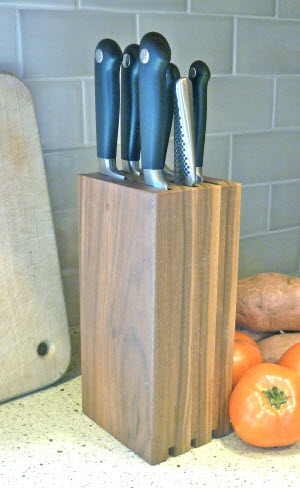 Storing kitchen knives is a perpetual problem. Some people buy them one past one, and when non in utilise, the knives jangle within a drawer getting tedious and nicked. Other people shop an enormous fix of ix or x kitchen knives, six steak knives, pair of scissors, and a sharpening steel in a huge angled knife cake on the countertop. The angled block takes up valuable countertop real-estate fifty-fifty though only half dozen or 7 knives are regularly used. I am sure you know people like this (maybe you're even one of them!) My upright blueprint takes upwardly less countertop space and shows off the natural beauty of night walnut woods.The design is actually elementary: four vertical boards separated by 10 strategically placed dividers. The dividers are shorter than the verticals and then there is room to facilitate evaporation in case a knife is inserted moisture afterwards washing. Information technology would be easy to make 3 or iv of these in an afternoon, reserving an additional afternoon for finishing.
Storing kitchen knives is a perpetual problem. Some people buy them one past one, and when non in utilise, the knives jangle within a drawer getting tedious and nicked. Other people shop an enormous fix of ix or x kitchen knives, six steak knives, pair of scissors, and a sharpening steel in a huge angled knife cake on the countertop. The angled block takes up valuable countertop real-estate fifty-fifty though only half dozen or 7 knives are regularly used. I am sure you know people like this (maybe you're even one of them!) My upright blueprint takes upwardly less countertop space and shows off the natural beauty of night walnut woods.The design is actually elementary: four vertical boards separated by 10 strategically placed dividers. The dividers are shorter than the verticals and then there is room to facilitate evaporation in case a knife is inserted moisture afterwards washing. Information technology would be easy to make 3 or iv of these in an afternoon, reserving an additional afternoon for finishing.
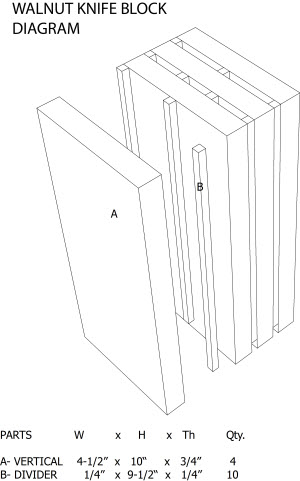 My design divides the block upward to store seven knives; the big knife slots are most 1-vii/viii? broad, which are perfect for chef'south knives, and the smaller slots are ane-1/8? wide for paring and peeling knives. You can customize it easily for your recipient. I also call back the pocketknife cake would look great in contrasting wood. Nighttime walnut and creamy colored maple always makes a corking combination. Have fun! Your mother-in-law is going to love yous!
My design divides the block upward to store seven knives; the big knife slots are most 1-vii/viii? broad, which are perfect for chef'south knives, and the smaller slots are ane-1/8? wide for paring and peeling knives. You can customize it easily for your recipient. I also call back the pocketknife cake would look great in contrasting wood. Nighttime walnut and creamy colored maple always makes a corking combination. Have fun! Your mother-in-law is going to love yous!

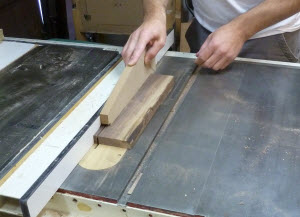
MILL THE PARTS TO SIZE
I rip 1/4? wide blanks for the knife block dividers, using a sacrificial push block for the safest functioning. I brand as many of these strips as I'll need for dividers.
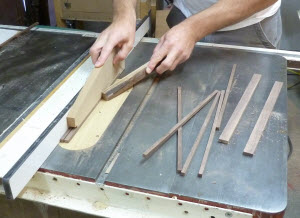 I utilise the double push block method to rip i/four? 10 1/four? square lengths. The divider bare is as wide as my push block, so I use a second push block to hold the stock tight confronting the fence. I only count on one divider per bare, as it is very difficult to control a thinner blank that is completely hidden past the push cake.
I utilise the double push block method to rip i/four? 10 1/four? square lengths. The divider bare is as wide as my push block, so I use a second push block to hold the stock tight confronting the fence. I only count on one divider per bare, as it is very difficult to control a thinner blank that is completely hidden past the push cake.
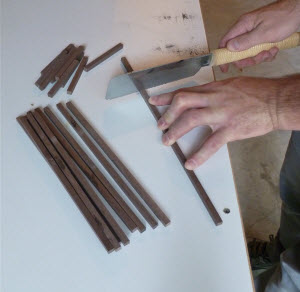 I am always reluctant to apply a miter saw or table saw to cutting small parts. Instead, I use a Japanese saw to chop the dividers to length. This razor sharp saw cuts these in no time apartment.
I am always reluctant to apply a miter saw or table saw to cutting small parts. Instead, I use a Japanese saw to chop the dividers to length. This razor sharp saw cuts these in no time apartment.
 Later on ripping the verticals to width, I crosscut all four of the large pieces at once. This way, they are all guaranteed to exist the same length. You can utilise a terminate block, but I just align them all and chop to length. Make certain your chop saw tin handle this much height; of course, y'all tin can use a miter sled on the table saw, too.
Later on ripping the verticals to width, I crosscut all four of the large pieces at once. This way, they are all guaranteed to exist the same length. You can utilise a terminate block, but I just align them all and chop to length. Make certain your chop saw tin handle this much height; of course, y'all tin can use a miter sled on the table saw, too.
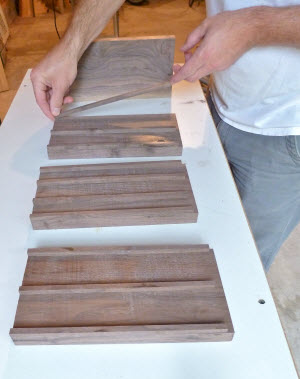
ASSEMBLY AND Glue-Upwardly
I similar to lay out all of my parts of the three sub-assemblies to brand sure they fit correctly before I commit with glue. The dividers are 1/2? shorter than the verticals, and then be sure to align them to i end. Although the glue up is elementary, there are fourteen pieces, and so information technology never hurts to double bank check.
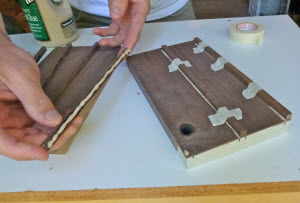 Later on I accept laid all of the dividers out, I mucilage up three sub-assemblies of dividers and verticals. I use copious amounts of glue and "clamp" the dividers downward with masking tape. Brand sure there is a lot of squeeze out on each sub-assembly. I employ masking record on the end of the verticals to mark my parts with permanent mark; pencil is hard to come across on walnut, and permanent marker seeps into finish grain and is hard to sand off.
Later on I accept laid all of the dividers out, I mucilage up three sub-assemblies of dividers and verticals. I use copious amounts of glue and "clamp" the dividers downward with masking tape. Brand sure there is a lot of squeeze out on each sub-assembly. I employ masking record on the end of the verticals to mark my parts with permanent mark; pencil is hard to come across on walnut, and permanent marker seeps into finish grain and is hard to sand off.
 Once the glue has fix for an hour or so, it is time to ready the sub-assemblies together. I utilise a bead of glue across the tops of the dividers and continue with each sub-associates until all are stacked up.
Once the glue has fix for an hour or so, it is time to ready the sub-assemblies together. I utilise a bead of glue across the tops of the dividers and continue with each sub-associates until all are stacked up.
 A concrete cake is the most rudimentary clamp! If I were using clamps, it would exist really difficult to keep the faces aligned because when the clamps are tightened down, the parts slide. Not and then with a concrete block which relies on good old-fashioned gravity. I leave this undisturbed for a couple of hours and let the weight of the block work its magic.
A concrete cake is the most rudimentary clamp! If I were using clamps, it would exist really difficult to keep the faces aligned because when the clamps are tightened down, the parts slide. Not and then with a concrete block which relies on good old-fashioned gravity. I leave this undisturbed for a couple of hours and let the weight of the block work its magic.

Make clean-Upward AND FINISHING
I plane any unevenness off the edges with a finely tuned hand plane subsequently the mucilage has set. I likewise chamfer all of the edges while I take the mitt plane out. Of course, if you are uncomfortable with a plane, you tin can use sandpaper instead.
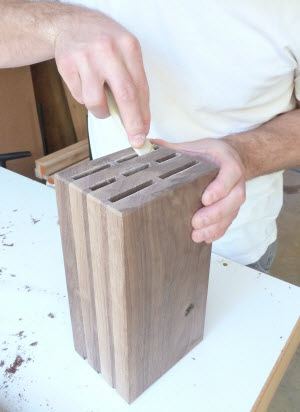 I wrap a piece of sandpaper around a sparse, broad stick and employ that to make clean the pocketknife slots. I flip the block over and round the edges on the lesser as well.
I wrap a piece of sandpaper around a sparse, broad stick and employ that to make clean the pocketknife slots. I flip the block over and round the edges on the lesser as well.
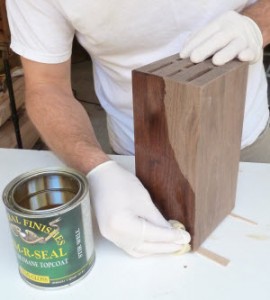 I employ a wiping cloth to apply three coats of oil-based polyurethane to the block. 2 pieces of fleck agree the block off my work surface so I tin apply finish to every side of the block at in one case. I squeeze the cloth and gently wedge it into the knife slots to stop the insides as well. Sand with 320-dust newspaper betwixt applications. If you can, wait a day or 2 for the finish to dry before wrapping the knife cake and putting information technology under the tree.
I employ a wiping cloth to apply three coats of oil-based polyurethane to the block. 2 pieces of fleck agree the block off my work surface so I tin apply finish to every side of the block at in one case. I squeeze the cloth and gently wedge it into the knife slots to stop the insides as well. Sand with 320-dust newspaper betwixt applications. If you can, wait a day or 2 for the finish to dry before wrapping the knife cake and putting information technology under the tree.
Photos By Author

Source: https://www.wwgoa.com/article/walnut-knife-block/
0 Response to "In Drawer Knife Block Woodworking Plans"
Yorum Gönder